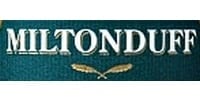Miltonduff distillery information
The Miltonduff distillery was founded by Andrew Pearey & Robert Bain (using the name Miltonduff-Glenlivet) in 1824 on the grounds of Pluscarden Abbey in the Speyside region, some six miles south-west of Elgin, in “Pluscarden”, an area that once was rumored to have hosted some 50 illicit distilleries. The distillery was established in Milton, once home to the old meal mill of the Abbey. The land was later acquired by the Duff family, hence the name Milton of Duff.
In 1866, the distillery was acquired by William Stuart, one of the co-proprietors of the Highland Park distillery). He remained at the helm for 24 years, when he was joined by Thomas Yool & Co. who acquired shares in the distillery in 1890. In the following decade, Miltonduff was extended, achieving a production of over 1,000,000 liters annually; quite an accomplishment for the time. The Pattinson crsis that wrecked the whisky business around the turn of the century also hit Miltonduff hard, causing them to be forced to reduce production. At some point Thomas Yool & Co. took over the distillery altogether.
In 1936, Hiram Walker-Gooderman & Worts Ltd. bought the distillery and the lands, having purchased the Ballantines brand just a year earlier using the profits the Canadian blender made due to the US prohibition. Walker was under pressure to expand in Scotland, as their competitor Seagram forced distilleries owned by Distillers COmpany Limited (DCL) to exclusively deliver to him and not Walker, in an attempt to stiffle competition. This meant Walker needed to secure sufficient whisky for his blends. The acquisition of Miltonduff (as well as Glenburgie) helped to full-fill the needs.
During the 1960s, the stills were switched to a new heating system, using water from the condensers through heat exchangers in order to heat the wash, and in 1964 a pair of Lomond stills was installed. These were used to produce a whisky that was sold under the name “Mosstowie”. You’d be hard pressed to find it nowadays, though, as the Lomond stills were removed again in 1981 due to demand for Mosstowie being low.
In 1986, Allied Distillers purchased a majority share in Hiram Walker & Sons, and the remainder of the shares a year later in 1987. Allied Distiller’s itself was absorbed by Pernod Ricard in 2005, along with the Ballantines brand and the Miltonduff distillery.
The site of the distillery used to house a technical research center belonging to Allied Domecq, containing warehouses, engineering facilities and a laboratory. Following the takeover by Pernod Ricard these facilities were moved to the Glen Keith Technical Centre, with the buildings now housing the Chivas’ Brothers northern operations headquarters. The Miultonduff site also became home to a dark grain plant, where the malt left after distillation and the pot ale are turned into cattle feed.
Miltonduff whisky
Most whisky produced at Miltonduff finds its ways into blends, particularly Ballantines, Teacher’s and Old Smuggler. Some official expressions that were released in the past include:
- 12 Years Old
- 15 Years Old (released in 2002)
- Gordon & MacPhail also released a 10 year old expression under license
Distillery info:
| Name | Miltonduff |
| Region | Speyside |
| Logo |  |
| Status | Active |
| Founded | 1824 |
| Water source | The Black Burn |
| Owned by | Chivas Brothers / Pernod Ricard |
| Address |
Chivas Bros +44 (0) 1343 554120 |
| Visitor centre | No |
| Website | N/A |
| N/A | |
| N/A | |
| Community | N/A |
| Map |
Distillery Setup:
Component |
Capacity |
Quantity |
|---|---|---|
| Mash tun | 14.5 tonnes | 1 (Full-Lauter) |
| Washback | 50,000 litres | 16 (Stainless Steel) |
| Wash still | 18,100 litres | 3 |
| Spirit Still | 18,400 litres | 3 |
| Expected yearly output in LPA (Litres of pure alcohol) | 5,400,000 |